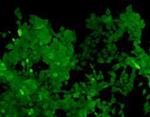Search Thermo Fisher Scientific
产品信息
PA5-119999
种属反应
宿主/亚型
分类
类型
抗原
偶联物
形式
浓度
纯化类型
保存液
内含物
保存条件
运输条件
RRID
产品详细信息
Positive Control: CRISPR-Cas9 transfected 293 cells
靶标信息
Cas9 is an RNA-guided DNA endonuclease enzyme associated with the CRISPR (Clustered Regularly Interspaced Short Palindromic Repeats) adaptive immunity system in bacteria and genetic engineering. The system is unique and flexible due to its dependence on RNA as the element that targets the nuclease to a desired DNA sequence. It can be used to induce indel mutations, specific sequence replacements/insertions, and large deletions or genomic rearrangements at any desired location in the genome. In addition, Cas9 can also be used to mediate upregulation of specific endogenous genes or to alter histone modifications or DNA methylation. Cas9 may be derived from Streptococcus pyogenes (SpCas9) or Staphylococcus aureus (SaCas9). SaCas9 has a number of properties that make it advantageous for genome editing, including its small size, high efficiency, nickase activity, and apparent specificity. SaCas9 principally recognizes an NNGRRT protospacer adjacent motif (PAM) and cleaves target DNA at rates comparable to SpCas9 with an ideal spacer lengths of 24 to 20 nucleotides. In comparison to SpCas9, SaCas9 is smaller (1368 AA versus 1053 AA) and generates indels at a comparable rate when directed against target DNA with the mutually permissive NGGRRT PAM. This makes it the preferred enzyme for all-in-one delivery of Cas9 and multiple gRNA expression cassettes with Adeno-associated vectors.
仅用于科研。不用于诊断过程。未经明确授权不得转售。
篇参考文献 (0)
生物信息学
蛋白别名: cas9; CASP 9; Caspase-9 precursor; CASPASE-9c; Caspase9; CRISPR-Cas9; CRISPR9; CTD; OTTHUMP00000002324; RNCASP9; RP11-265F14.3; s aureus





